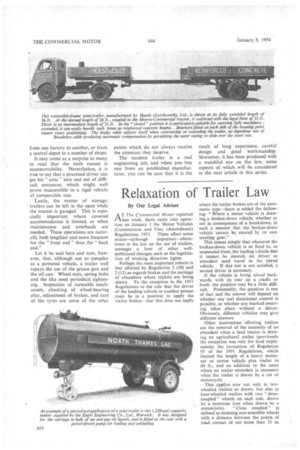Relaxation of Trailer Law
Page 48

If you've noticed an error in this article please click here to report it so we can fix it.
By Our Legal Adviser As The Commercial Motor reported .last week, there came into operation on January 1 the Motor Vehicles (Construction and Use) (Amendment) Regulations, 1953. These effect some minor—although important—alterations in the law on the use-of trailers, amongst a host of other well publicized changes, such as the legalization of winking direction lights.
Perhaps the most important reform is that effected by RegulatiOn 2 ,(10) and 2 (12) as regards brakes and the carriage of attendants where trailers are being drawn. To the exception in the 1951 Regulations to the rule that the driver of the leading vehicle or-another person .,must be in a position to apply the trailer brakes—that this does not apply
where the trailer brakes are of the automatic type—there is added the following: "Where a motor vehicle is drawing a broken-down vehicle, whether or not in consequence of a breakdown, in such a manner that the broken-down vehicle cannot be steered by its own
steering gear."
This means simply that whenever the broken-down vehicle is so fixed -to, or suspended from, the leading vehicle that it cannot be steered, no driver or attendant need travel in the towed vehicle. If this test is not satisfied, a second driver is necessary.
If the vehicle is being towed backwards, with its rear on a cradle or hook. the position may be a little difficult. Presumably, the question is one of fact and the answer will depend on whether any real directional control is possible, or whether any marked swerving takes place without a driver. Obviously, different vehicles may give different answers.
Other innovations affecting trailers are the removal of the necessity of an attendant when a land tractor is drawing an agricultural trailer (previously the exception was only for land implements); the revocation of Regulation 93 of the 1951 Regulations, which limited the length of a heavy motorcar or motor vehicle plus trailer to 60 ft.; and an addition to the cases where no trailer attendant is necessary when the trailer is drawn by a car or Motorcycle.
This applies now not only to twowheeled trailers so drawn, but also to ,four-wheeled trailers with two " closecoupled " wheels on each side, drawn by a motorcar (not when drawn by a motorcycle). "Close coupled" is defined as meaning non-steerable wheels with a distance between the points of road contact of not more than 33 in.




































































































